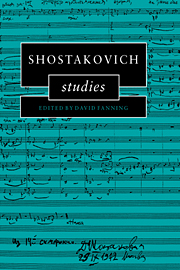Book contents
- Frontmatter
- Contents
- Acknowledgments
- 1 Introduction. Talking about eggs: musicology and Shostakovich
- 2 Public lies and unspeakable truth interpreting Shostakovich's Fifth Symphony
- 3 Form in Shostakovich's instrumental works
- 4 Russian theorists on modality in Shostakovich's music
- 5 The cycle of structure and the cycle of meaning: the Piano Trio in E minor, Op. 67
- 6 Leitmotif in Lady Macbeth
- 7 From Lady Macbeth to Katerina Shostakovich's versions and revisions
- 8 The Golden Age: the true story of the première
- 9 ‘And art made tongue-tied by authority’ Shostakovich's song-cycles
- 10 A debt repaid? Some observations on Shostakovich and his late-period recognition of Britten
- 11 Shostakovich and Schnittke: the erosion of symphonic syntax
- Index
5 - The cycle of structure and the cycle of meaning: the Piano Trio in E minor, Op. 67
Published online by Cambridge University Press: 22 October 2009
- Frontmatter
- Contents
- Acknowledgments
- 1 Introduction. Talking about eggs: musicology and Shostakovich
- 2 Public lies and unspeakable truth interpreting Shostakovich's Fifth Symphony
- 3 Form in Shostakovich's instrumental works
- 4 Russian theorists on modality in Shostakovich's music
- 5 The cycle of structure and the cycle of meaning: the Piano Trio in E minor, Op. 67
- 6 Leitmotif in Lady Macbeth
- 7 From Lady Macbeth to Katerina Shostakovich's versions and revisions
- 8 The Golden Age: the true story of the première
- 9 ‘And art made tongue-tied by authority’ Shostakovich's song-cycles
- 10 A debt repaid? Some observations on Shostakovich and his late-period recognition of Britten
- 11 Shostakovich and Schnittke: the erosion of symphonic syntax
- Index
Summary
Sometimes we encounter a work for which a standard critical interpretation seems so solidly secured by the tight fit of the circumstances of its composition and the music itself that we see little reason to engage the music more closely and seek for it a more careful and nuanced reading. Such a work is Shostakovich's Piano Trio in E minor, Op. 67. Wherever we look, it seems, whether in biographies of the composer, critical studies, programme notes or liner notes in recording, we read that the composition of the Trio was Shostakovich's anguished response to the sudden and unexpected death, in February 1944, of his closest friend, the musical writer and scholar Ivan Sollertinsky, to whom the work is dedicated; that it was during this same time that Shostakovich learned of the Nazi concentration camps at Treblinka and elsewhere, and that the grotesque, dance-like, allegretto finale, the first of his ‘Jewish’ works of the mid- to late 1940s and early 1950s, is a grim commentary on the camps; and finally, that the work as a whole, especially the last two movements, is permeated with images of death.
Now there is little reason to revise the main lines of this standard interpretation, which, given the biographical and musical evidence that supports it, seems wellnigh unassailable. But the ostensible transparency of the Trio masks an elegant and compelling musical argument that the conventional wisdom about the piece has discouraged us from hearing. The aspect of the work that most needs to be problematised is the very feature that seems most straightforward about it: the cyclic return of themes.
- Type
- Chapter
- Information
- Shostakovich Studies , pp. 113 - 136Publisher: Cambridge University PressPrint publication year: 1995
- 2
- Cited by



